Superphylum Heterokonta Rank Forma specialis | Higher classification Peronospora | |
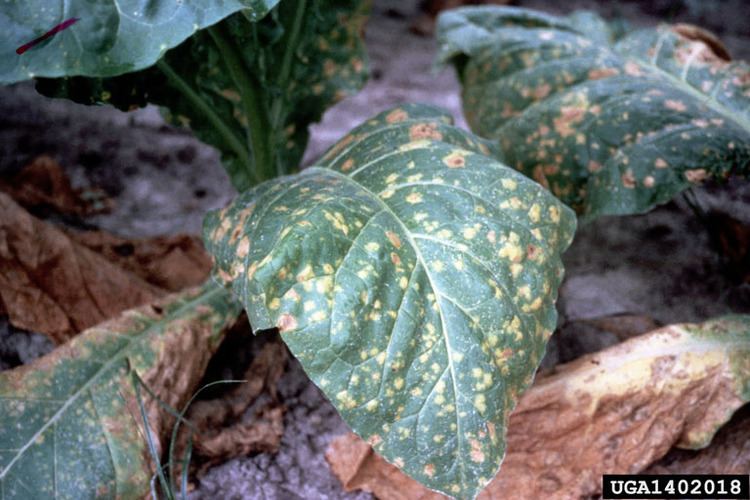 | ||
Species P. hyoscyami f.sp. tabacina Scientific name Peronospora hyoscyami f.sp. tabacina Similar Peronospora, Oomycete, Pseudoperonospora, Peronospora destructor, Pseudoperonospora cubensis | ||
Peronospora hyoscyami f.sp. tabacina is a plant pathogen infecting tobacco that causes blue mold. It is an oomycete (a fungus-like organism) that is highly destructive toward seed plants. The tabacina is also very alarming towards humid farming zones, like the southeastern and eastern U.S., Canada, and countries boarding the Caribbean. The disease was first identified in 1921 in Florida and Georgia Ten years later the same disease was found once again in the same region of the U.S. The disease began to spread into Virginia, Maryland, and North Carolina. A few years later the disease reached Kentucky and Tennessee. In 1960 a blue mold epidemic spread on tobacco in approximately eleven countries. There was approximately twenty five million dollars in losses which is nearly thirty percent of tobacco plants. Each year Peronospora Hyoscyami is introduced as blue mold, known as windblown spores from outside the region by infected transplants.
Contents
- Symptoms
- Spreading the Disease
- Host Pathogen Interaction
- Tobacco Defense to P hyoscyami fsp tabacina
- Prevention
- References
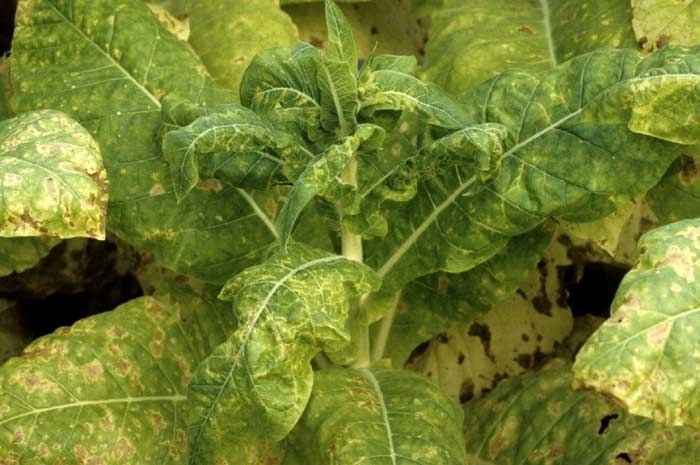
Symptoms
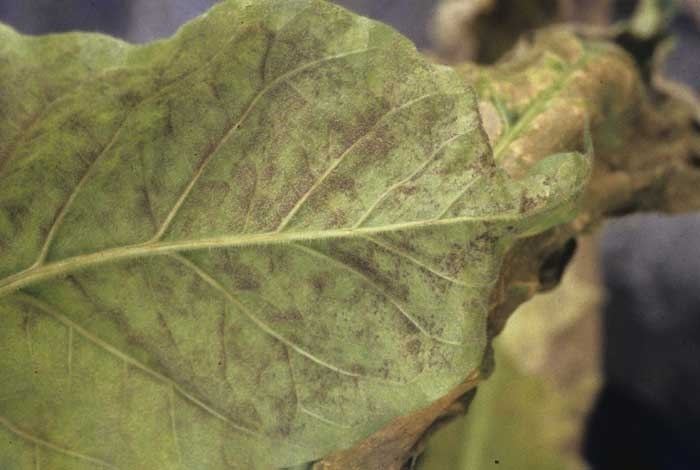
Tobacco plants with an upright position of small patches of the seed bed are typically early signs of blue mold. These leaves are usually two to four centimeters in diameter, and normally spotted with yellow, gray, or a bluish mold in the lower surface. Younger plants that are up to four weeks old and are affected by the disease are easily killed by the fungus. Older plants become deformed and dark, indicating that parts of the plant are dead. In more severe cases the stem and root become infected and turn to a brownish color. The observation of downy mold in the lower surface of the leaf is the most reliable symptom of blue mold. Downy mold carries thousands of small reproductive units called conidia If conidia forms at different spots in the seedbed an outbreak is more than likely to occur. The symptoms usually take place before it’s obvious. The symptoms evolve rapidly and are typically noticeable over night. The fungus frequently takes place when the vein of the leaves reaches vascular tissue of the stem, causing weakness and lodging. This infection is called "systemic infection". The infection causes a stunt in growth and the leaves become narrow and short. The vascular system of the plants usually turns brown in color and the weakened stalk usually causing the stalk to fall over. The fungus is highly weather sensitive. During the time when the weather is cool, wet, or when there’s an overcast the disease can evolve in a greenhouse or field. The disease spreads rapidly because of the fungal pathogen. The rate of continental spread is based on the potential for high levels of inoculum and effective wind spores. When the weather is clear, dry, and hot the disease usually stops spreading and more than likely stops all together.
Spreading the Disease
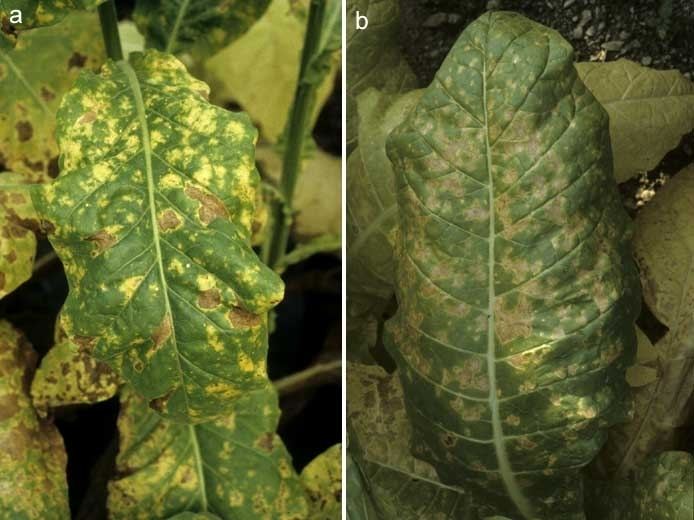
A major way blue mold spreads is by the distribution of infected transplants. Even though they may appear to be healthy they can still hold the infection.Farmers generally buy transplants from other growers, and take risks of possibly buying diseased plants. If these plants are diseased they are risking their other plants of getting blue mold. This can affect their entire region of their tobacco plants. A five- to seven-day symptom-free plant takes place before the first appearance of a diseased plant is visible. When weather conditions are reasonable a second set of spores evolves around a seven- to a ten-day period. If these plants are not chemically treated quickly the cycle may be repeated several times during the growing season. This can cause a huge epidemic causing many plants to be infected. Blue mold has been found to come into play three times each week from March to August
Host - Pathogen Interaction
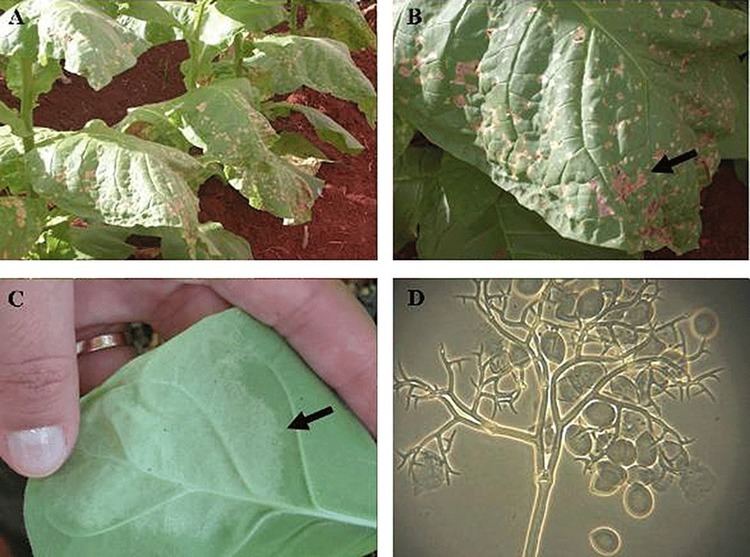
After the germination of conidia, the initial penetration of the host depends on the formation of appressoria near the stomata. This is largely due to a response of P. hyoscyami f.sp. tabacina to topographical cues of the host such as stomatal openings. Upon entry of an infection peg through a stomatal opening, hyphae grow and develop between plant cells. When hyphae reach a photosynthetic mesophyll cell a peg penetrates the cell and establishes a haustorium which the fungus uses to absorb the necessary nutrients for its own growth. Through the establishment of haustoria the pathogen develops an intimate relationship with the host. In doing so P. hyoscyami f.sp. tabacina efficiently redirects the nutrients of the host and delivers effector proteins into the host cytoplasm that suppress the host defense response.
Tobacco Defense to P. hyoscyami f.sp. tabacina
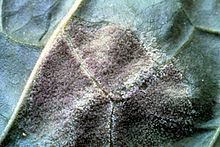
The activation of systemic acquired resistance (SAR) has shown to be an effective management strategy for P. hyoscyami f.sp. tabacina. It has been documented that an accumulation of pathogenesis related proteins (PR proteins) and increased activities of peroxidase, β-1, 3-glucanase, and chitinases have been shown to be associated with induced resistance in tobacco to P. hyoscyami f.sp. tabacina. In addition, PR proteins have been shown to have antifungal activities in vitro and thus are thought to be a key component in the resistance of tobacco to blue mold. Of the tobacco defense responses to P. hyoscyami f.sp. tabacina SAR has been characterized as the best activated response to blue mold.
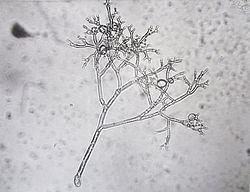
In addition to SAR, tobacco plants have been found to secret β – inone and T-phylloplanin which both inhibit the sporulation and growth of P. hyoscyami f.sp. tabacina. T-phylloplanin proteins are secreted by tall glandular trichomes on the aerial surface of tobacco leaves and may be a novel leaf surface defense molecule in tobacco.
Prevention
"The disease is getting harder to manage and is becoming a problem". The way to prevent the disease is to manage your own crops. Protect plants with fungicides when they are most vulnerable. Take control of these crops early on. Make the environment less favorable for the pathogen to survive and protect the tobacco. Always keep the pathogen out of tobacco and the area for as long as possible. Farmers are always able to grow their own plants so as to not purchase them from others which should reduce the chance of planting diseased plants.
